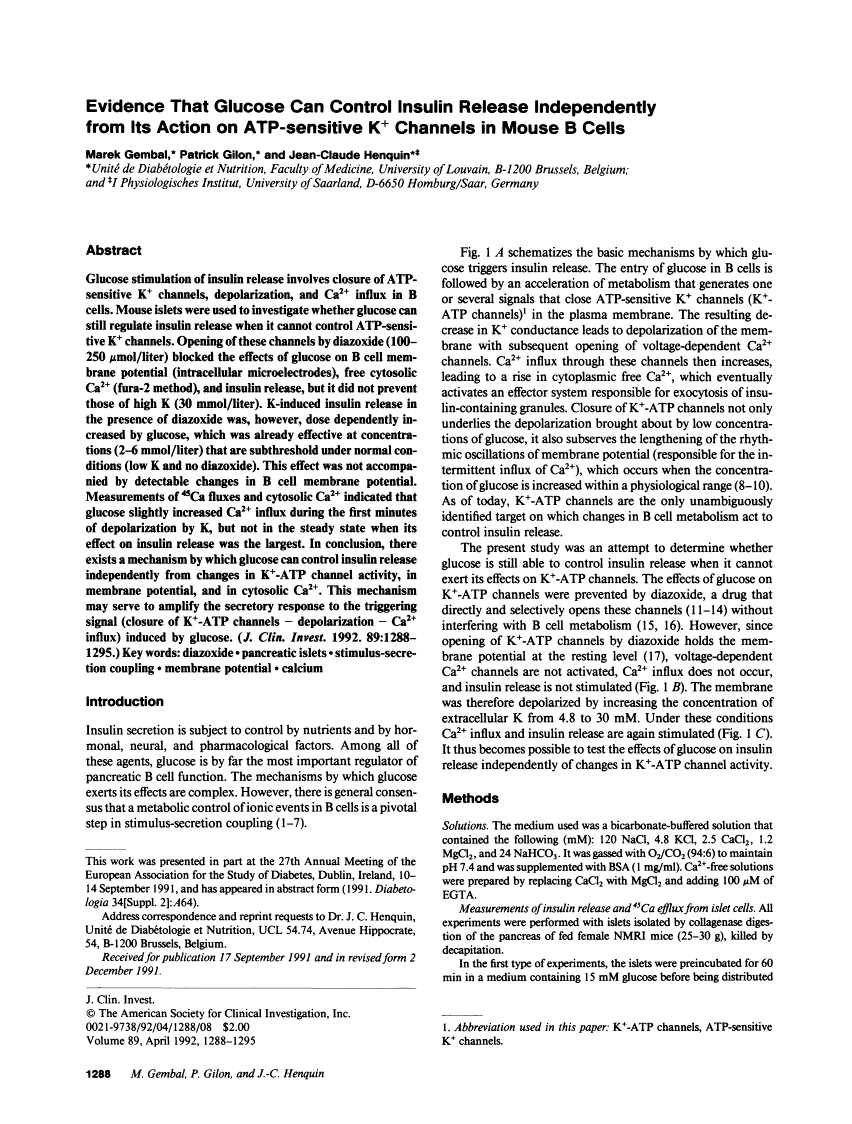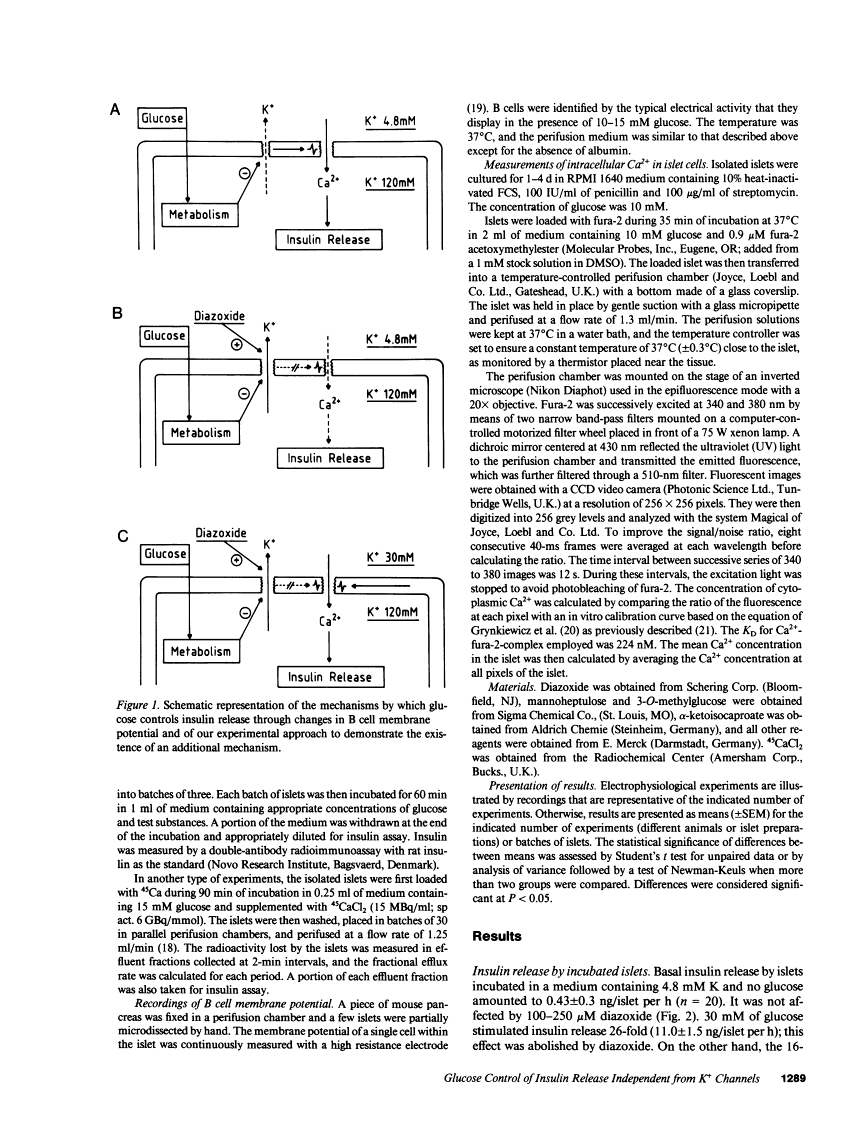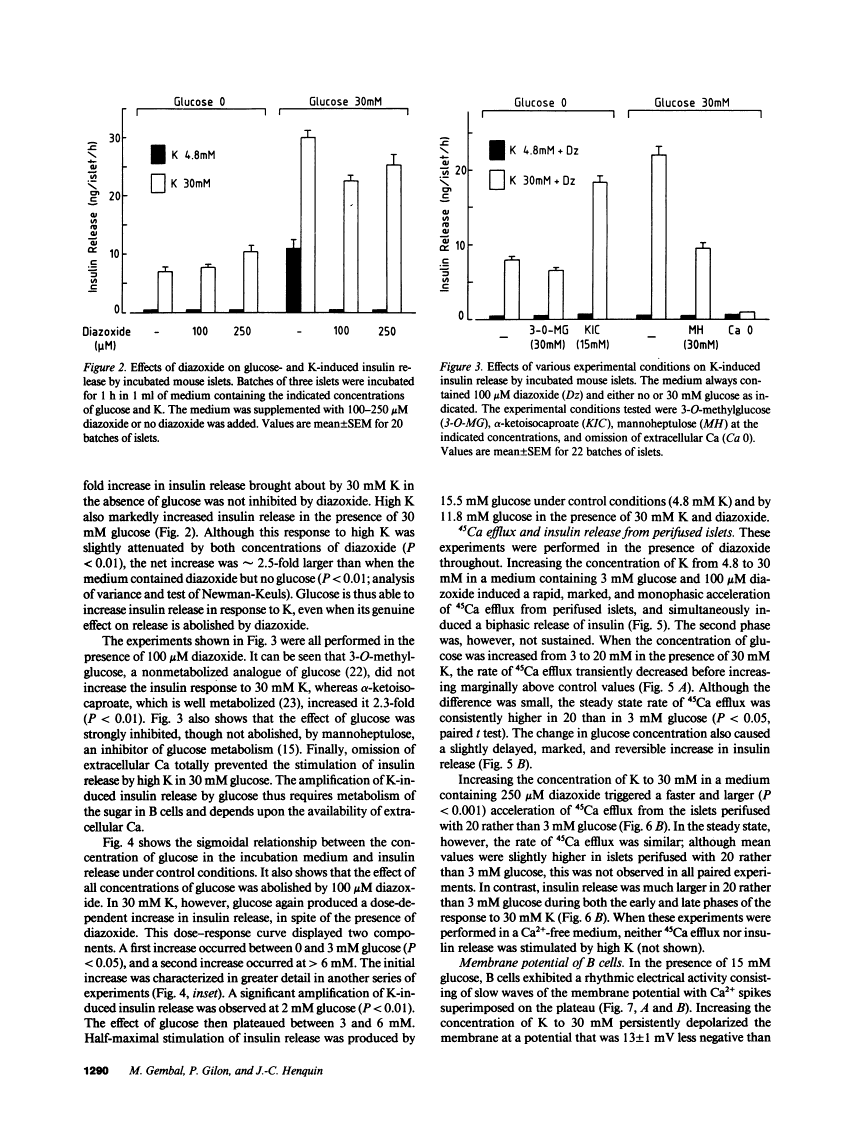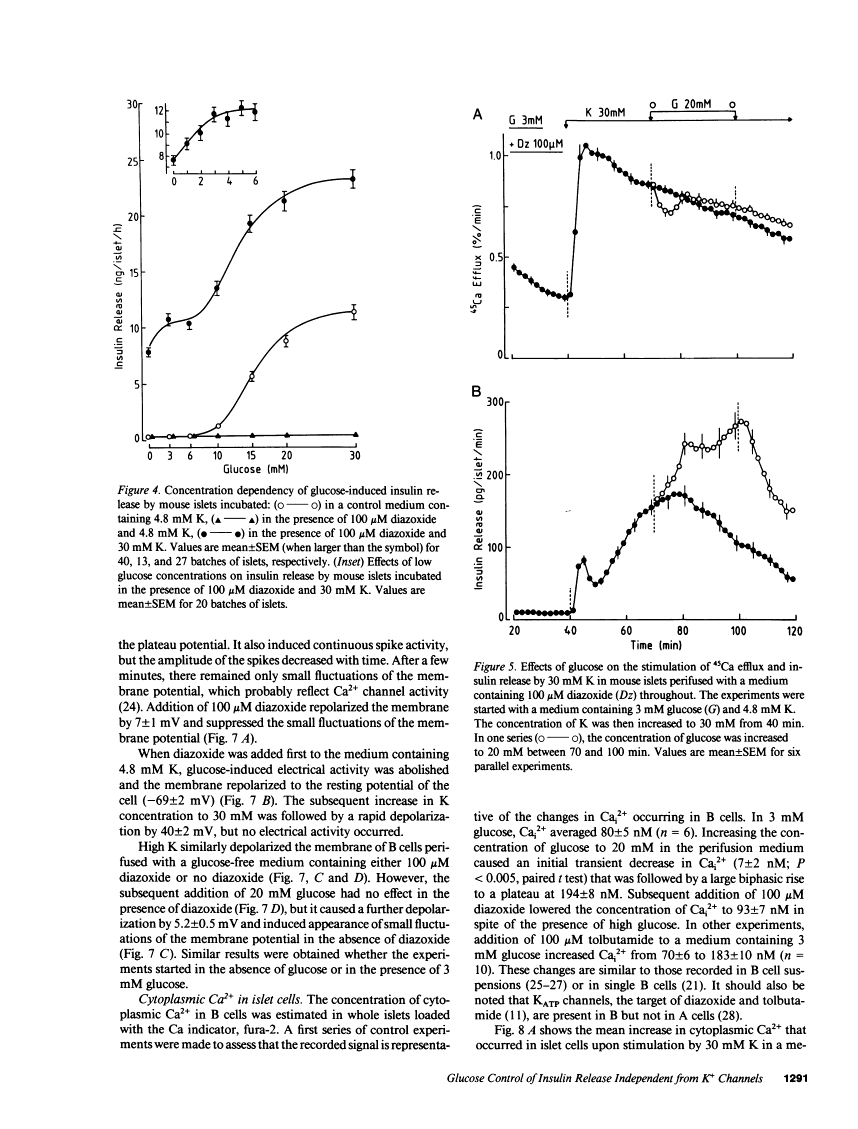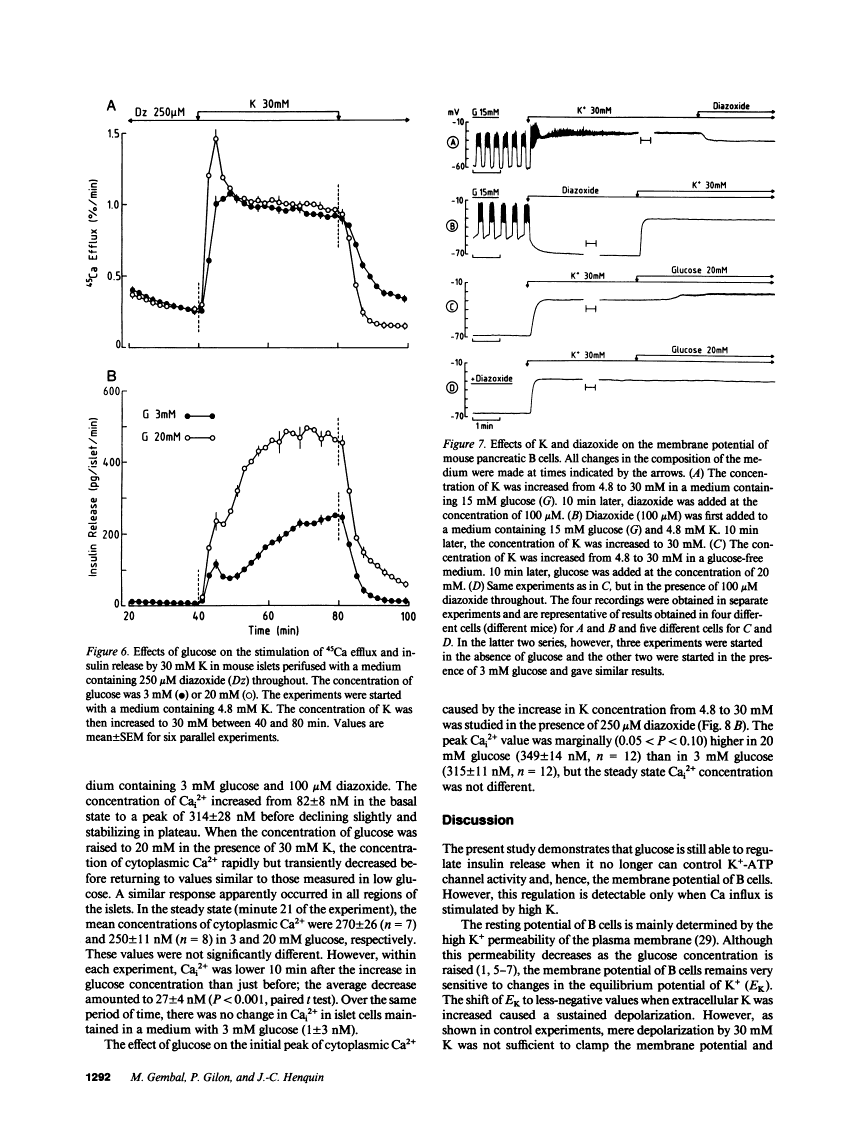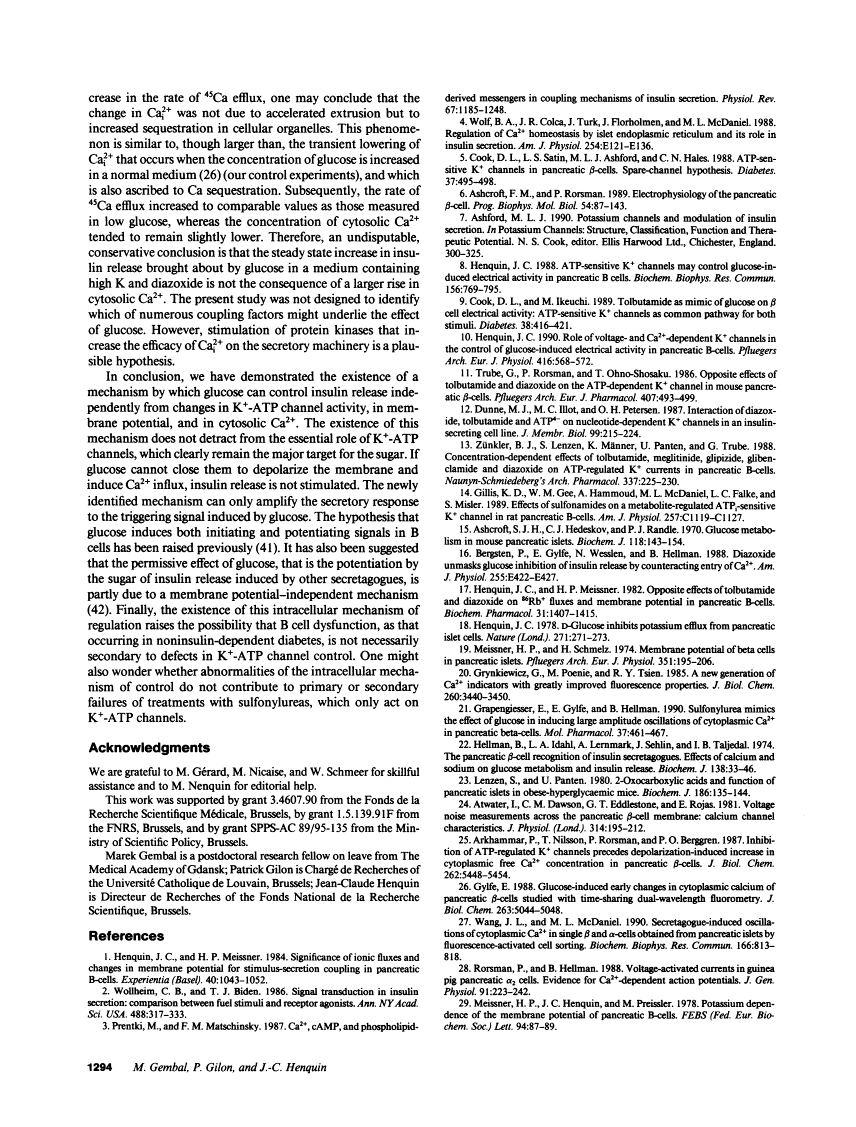Abstract
Free full text

Evidence that glucose can control insulin release independently from its action on ATP-sensitive K+ channels in mouse B cells.
Abstract
Glucose stimulation of insulin release involves closure of ATP-sensitive K+ channels, depolarization, and Ca2+ influx in B cells. Mouse islets were used to investigate whether glucose can still regulate insulin release when it cannot control ATP-sensitive K+ channels. Opening of these channels by diazoxide (100-250 mumol/liter) blocked the effects of glucose on B cell membrane potential (intracellular microelectrodes), free cytosolic Ca2+ (fura-2 method), and insulin release, but it did not prevent those of high K (30 mmol/liter). K-induced insulin release in the presence of diazoxide was, however, dose dependently increased by glucose, which was already effective at concentrations (2-6 mmol/liter) that are subthreshold under normal conditions (low K and no diazoxide). This effect was not accompanied by detectable changes in B cell membrane potential. Measurements of 45Ca fluxes and cytosolic Ca2+ indicated that glucose slightly increased Ca2+ influx during the first minutes of depolarization by K, but not in the steady state when its effect on insulin release was the largest. In conclusion, there exists a mechanism by which glucose can control insulin release independently from changes in K(+)-ATP channel activity, in membrane potential, and in cytosolic Ca2+. This mechanism may serve to amplify the secretory response to the triggering signal (closure of K(+)-ATP channels--depolarization--Ca2+ influx) induced by glucose.
Full text
Full text is available as a scanned copy of the original print version. Get a printable copy (PDF file) of the complete article (1.4M), or click on a page image below to browse page by page. Links to PubMed are also available for Selected References.
Selected References
These references are in PubMed. This may not be the complete list of references from this article.
- Henquin JC, Meissner HP. Significance of ionic fluxes and changes in membrane potential for stimulus-secretion coupling in pancreatic B-cells. Experientia. 1984 Oct 15;40(10):1043–1052. [Abstract] [Google Scholar]
- Wollheim CB, Biden TJ. Signal transduction in insulin secretion: comparison between fuel stimuli and receptor agonists. Ann N Y Acad Sci. 1986;488:317–333. [Abstract] [Google Scholar]
- Prentki M, Matschinsky FM. Ca2+, cAMP, and phospholipid-derived messengers in coupling mechanisms of insulin secretion. Physiol Rev. 1987 Oct;67(4):1185–1248. [Abstract] [Google Scholar]
- Cook DL, Satin LS, Ashford ML, Hales CN. ATP-sensitive K+ channels in pancreatic beta-cells. Spare-channel hypothesis. Diabetes. 1988 May;37(5):495–498. [Abstract] [Google Scholar]
- Ashcroft FM, Rorsman P. Electrophysiology of the pancreatic beta-cell. Prog Biophys Mol Biol. 1989;54(2):87–143. [Abstract] [Google Scholar]
- Henquin JC. ATP-sensitive K+ channels may control glucose-induced electrical activity in pancreatic B-cells. Biochem Biophys Res Commun. 1988 Oct 31;156(2):769–775. [Abstract] [Google Scholar]
- Cook DL, Ikeuchi M. Tolbutamide as mimic of glucose on beta-cell electrical activity. ATP-sensitive K+ channels as common pathway for both stimuli. Diabetes. 1989 Apr;38(4):416–421. [Abstract] [Google Scholar]
- Henquin JC. Role of voltage- and Ca2(+)-dependent K+ channels in the control of glucose-induced electrical activity in pancreatic B-cells. Pflugers Arch. 1990 Jul;416(5):568–572. [Abstract] [Google Scholar]
- Trube G, Rorsman P, Ohno-Shosaku T. Opposite effects of tolbutamide and diazoxide on the ATP-dependent K+ channel in mouse pancreatic beta-cells. Pflugers Arch. 1986 Nov;407(5):493–499. [Abstract] [Google Scholar]
- Dunne MJ, Illot MC, Peterson OH. Interaction of diazoxide, tolbutamide and ATP4- on nucleotide-dependent K+ channels in an insulin-secreting cell line. J Membr Biol. 1987;99(3):215–224. [Abstract] [Google Scholar]
- Zünkler BJ, Lenzen S, Männer K, Panten U, Trube G. Concentration-dependent effects of tolbutamide, meglitinide, glipizide, glibenclamide and diazoxide on ATP-regulated K+ currents in pancreatic B-cells. Naunyn Schmiedebergs Arch Pharmacol. 1988 Feb;337(2):225–230. [Abstract] [Google Scholar]
- Ashcroft SJ, Hedeskov CJ, Randle PJ. Glucose metabolism in mouse pancreatic islets. Biochem J. 1970 Jun;118(1):143–154. [Europe PMC free article] [Abstract] [Google Scholar]
- Bergsten P, Gylfe E, Wesslén N, Hellman B. Diazoxide unmasks glucose inhibition of insulin release by counteracting entry of Ca2+. Am J Physiol. 1988 Oct;255(4 Pt 1):E422–E427. [Abstract] [Google Scholar]
- Henquin JC, Meissner HP. Opposite effects of tolbutamide and diazoxide on 86Rb+ fluxes and membrane potential in pancreatic B cells. Biochem Pharmacol. 1982 Apr 1;31(7):1407–1415. [Abstract] [Google Scholar]
- Henquin JC. D-glucose inhibits potassium efflux from pancreatic islet cells. Nature. 1978 Jan 19;271(5642):271–273. [Abstract] [Google Scholar]
- Meissner HP, Schmelz H. Membrane potential of beta-cells in pancreatic islets. Pflugers Arch. 1974;351(3):195–206. [Abstract] [Google Scholar]
- Grynkiewicz G, Poenie M, Tsien RY. A new generation of Ca2+ indicators with greatly improved fluorescence properties. J Biol Chem. 1985 Mar 25;260(6):3440–3450. [Abstract] [Google Scholar]
- Grapengiesser E, Gylfe E, Hellman B. Sulfonylurea mimics the effect of glucose in inducing large amplitude oscillations of cytoplasmic Ca2+ in pancreatic beta-cells. Mol Pharmacol. 1990 Mar;37(3):461–467. [Abstract] [Google Scholar]
- Hellman B, Idahl LA, Lernmark A, Sehlin J, Täljedal IB. The pancreatic beta-cell recognition of insulin secretagogues. Effects of calcium and sodium on glucose metabolism and insulin release. Biochem J. 1974 Jan;138(1):33–45. [Europe PMC free article] [Abstract] [Google Scholar]
- Lenzen S, Panten U. 2-oxocarboxylic acids and function of pancreatic islets in obese-hyperglycaemic mice. Insulin secretion in relation to 45Ca uptake and metabolism. Biochem J. 1980 Jan 15;186(1):135–144. [Europe PMC free article] [Abstract] [Google Scholar]
- Atwater I, Dawson CM, Eddlestone GT, Rojas E. Voltage noise measurements across the pancreatic beta-cell membrane: calcium channel characteristics. J Physiol. 1981 May;314:195–212. [Abstract] [Google Scholar]
- Arkhammar P, Nilsson T, Rorsman P, Berggren PO. Inhibition of ATP-regulated K+ channels precedes depolarization-induced increase in cytoplasmic free Ca2+ concentration in pancreatic beta-cells. J Biol Chem. 1987 Apr 25;262(12):5448–5454. [Abstract] [Google Scholar]
- Gylfe E. Glucose-induced early changes in cytoplasmic calcium of pancreatic beta-cells studied with time-sharing dual-wavelength fluorometry. J Biol Chem. 1988 Apr 15;263(11):5044–5048. [Abstract] [Google Scholar]
- Wang JL, McDaniel ML. Secretagogue-induced oscillations of cytoplasmic Ca2+ in single beta and alpha-cells obtained from pancreatic islets by fluorescence-activated cell sorting. Biochem Biophys Res Commun. 1990 Jan 30;166(2):813–818. [Abstract] [Google Scholar]
- Rorsman P, Hellman B. Voltage-activated currents in guinea pig pancreatic alpha 2 cells. Evidence for Ca2+-dependent action potentials. J Gen Physiol. 1988 Feb;91(2):223–242. [Europe PMC free article] [Abstract] [Google Scholar]
- Meissner HP, Henquin JC, Preissler M. Potassium dependence of the membrane potential of pancreatic B-cells. FEBS Lett. 1978 Oct 1;94(1):87–89. [Abstract] [Google Scholar]
- Panten U, Burgfeld J, Goerke F, Rennicke M, Schwanstecher M, Wallasch A, Zünkler BJ, Lenzen S. Control of insulin secretion by sulfonylureas, meglitinide and diazoxide in relation to their binding to the sulfonylurea receptor in pancreatic islets. Biochem Pharmacol. 1989 Apr 15;38(8):1217–1229. [Abstract] [Google Scholar]
- Howell SL, Taylor KW. Effects of diazoxide on insulin secretion in vitro. Lancet. 1966 Jan 15;1(7429):128–129. [Abstract] [Google Scholar]
- Lin BJ, Haist RE. Effects of some modifiers of insulin secretion on insulin biosynthesis. Endocrinology. 1973 Mar;92(3):735–742. [Abstract] [Google Scholar]
- Leinweber KP, Schatz H. Long-term and short-term effects of calcium, verapamil and diazoxide on biosynthesis and release of (pro-) insulin in isolated islets of rat pancreas. Acta Endocrinol (Copenh) 1982 Jan;99(1):94–100. [Abstract] [Google Scholar]
- Pipeleers DG, Marichal M, Malaisse WJ. The stimulus-secretion coupling of glucose-induced insulin release. XV. Participation of cations in the recognition of glucose by the beta-cell. Endocrinology. 1973 Nov;93(5):1012–1018. [Abstract] [Google Scholar]
- Milner RD, Hales CN. The interaction of various inhibitors and stimuli of insulin release studied with rabbit pancreas in vitro. Biochem J. 1969 Jul;113(3):473–479. [Europe PMC free article] [Abstract] [Google Scholar]
- Henquin JC, Charles S, Nenquin M, Mathot F, Tamagawa T. Diazoxide and D600 inhibition of insulin release. Distinct mechanisms explain the specificity for different stimuli. Diabetes. 1982 Sep;31(9):776–783. [Abstract] [Google Scholar]
- Malaisse WJ, Sener A, Herchuelz A, Hutton JC. Insulin release: the fuel hypothesis. Metabolism. 1979 Apr;28(4):373–386. [Abstract] [Google Scholar]
- Meglasson MD, Matschinsky FM. New perspectives on pancreatic islet glucokinase. Am J Physiol. 1984 Jan;246(1 Pt 1):E1–13. [Abstract] [Google Scholar]
- Velasco JM, Petersen JU, Petersen OH. Single-channel Ba2+ currents in insulin-secreting cells are activated by glyceraldehyde stimulation. FEBS Lett. 1988 Apr 25;231(2):366–370. [Abstract] [Google Scholar]
- Smith PA, Rorsman P, Ashcroft FM. Modulation of dihydropyridine-sensitive Ca2+ channels by glucose metabolism in mouse pancreatic beta-cells. Nature. 1989 Nov 30;342(6249):550–553. [Abstract] [Google Scholar]
- Cerasi E. Mechanisms of glucose stimulated insulin secretion in health and in diabetes: some re-evaluations and proposals. Diabetologia. 1975 Feb;11(1):1–13. [Abstract] [Google Scholar]
- Hermans MP, Schmeer W, Henquin JC. The permissive effect of glucose, tolbutamide and high K+ on arginine stimulation of insulin release in isolated mouse islets. Diabetologia. 1987 Aug;30(8):659–665. [Abstract] [Google Scholar]
Associated Data
Articles from The Journal of Clinical Investigation are provided here courtesy of American Society for Clinical Investigation
Full text links
Read article at publisher's site: https://doi.org/10.1172/jci115714
Read article for free, from open access legal sources, via Unpaywall:
http://www.jci.org/articles/view/115714/files/pdf
Citations & impact
Impact metrics
Article citations
Unveiling islet heterogeneity using an automated microfluidic imaging system.
Sci Rep, 14(1):24707, 21 Oct 2024
Cited by: 0 articles | PMID: 39433829 | PMCID: PMC11493968
Hypertonicity during a rapid rise in D-glucose mediates first-phase insulin secretion.
Front Endocrinol (Lausanne), 15:1395028, 26 Jun 2024
Cited by: 0 articles | PMID: 38989001 | PMCID: PMC11233695
(Re-)Viewing Role of Intracellular Glucose Beyond Extracellular Regulation of Glucose-Stimulated Insulin Secretion by Pancreatic Cells.
ACS Omega, 9(10):11755-11768, 29 Feb 2024
Cited by: 1 article | PMID: 38496986 | PMCID: PMC10938456
Short-Term Inhibition of Translation by Cycloheximide Concurrently Affects Mitochondrial Function and Insulin Secretion in Islets from Female Mice.
Int J Mol Sci, 24(20):15464, 23 Oct 2023
Cited by: 1 article | PMID: 37895141 | PMCID: PMC10607510
Noncanonical Regulation of cAMP-Dependent Insulin Secretion and Its Implications in Type 2 Diabetes.
Compr Physiol, 13(3):5023-5049, 26 Jun 2023
Cited by: 0 articles | PMID: 37358504 | PMCID: PMC10809800
Go to all (252) article citations
Similar Articles
To arrive at the top five similar articles we use a word-weighted algorithm to compare words from the Title and Abstract of each citation.
Glucose regulation of insulin secretion independent of the opening or closure of adenosine triphosphate-sensitive K+ channels in beta cells.
Endocrinology, 140(5):2252-2257, 01 May 1999
Cited by: 39 articles | PMID: 10218978
Mechanisms by which glucose can control insulin release independently from its action on adenosine triphosphate-sensitive K+ channels in mouse B cells.
J Clin Invest, 91(3):871-880, 01 Mar 1993
Cited by: 147 articles | PMID: 8383702 | PMCID: PMC288039
Glucose triggers protein kinase A-dependent insulin secretion in mouse pancreatic islets through activation of the K+ATP channel-dependent pathway.
Eur J Endocrinol, 152(4):671-677, 01 Apr 2005
Cited by: 12 articles | PMID: 15817925
Triggering and amplifying pathways of regulation of insulin secretion by glucose.
Diabetes, 49(11):1751-1760, 01 Nov 2000
Cited by: 723 articles | PMID: 11078440
Review
